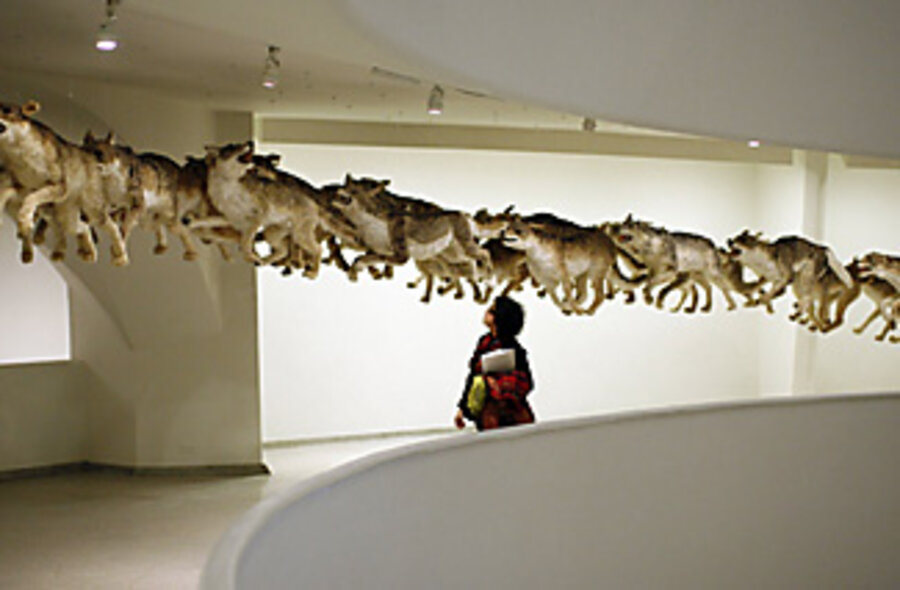Cai Guo-Qiang has a blast with explosive art
Loading...
| New York
The Guggenheim Museum's new art exhibition starts with a bang. Inside the building's central rotunda, a corkscrew mobile of nine cars flips through the seven-story space, light rods sparking from each vehicle. The overall effect of the installation, titled "Inopportune: Stage One," resembles a sequential, freeze-frame representation of a car bombing.
The artist, Cai Guo-Qiang, delights in creating "explosive events" – pyrotechnical displays as conceptual art – as well as smaller-scale works that harness the snap, crackle, and pop of gunpowder. "Cai Guo-Qiang: I Want to Believe," which unfurls at the Guggenheim through May 28, also showcases pioneering works in which the artist ignited gunpowder on fibrous paper to create provocative imagery.
Significantly, it's the first solo show the museum has offered a Chinese-born artist and signals the coming of age of a generation of postrevolutionary Chinese artists who are receiving much attention, among whom Cai (his name is pronounced Sigh Gwo Chang), is the best-known.
The slight 50-year-old, who now lives in New York, is about to become an even bigger name. As the art director of visual and special effects for the Beijing 2008 Olympics, his blazing creations will illumine the televised opening and closing ceremonies that will be watched by millions across the world.
In the meantime, the Guggenheim survey of more than 80 works from the 1980s to the present provides an incendiary introduction to his work. Cai collaborated with co-curators Thomas Krens and Alexandra Munroe to fill the Guggenheim with what he calls "a sense of energy and explosion." His site-specific installations, gunpowder drawings, and videos of past explosive events curl up the spiral ramps of the Guggenheim, which he imagined, he says through an interpreter, "as a scroll for you to unroll and walk through ... a scroll of my artistic career."
Growing up in the port city of Quanzhou on the Strait of Taiwan, the blast of bombs was background noise for Cai as Taiwan and the Mainland exchanged bombardments. Gunpowder, a Chinese invention, also fueled celebratory fireworks, displaying a benign, social use of its power.
Influenced by the Cultural Revolution of 1966-77, Cai saw these dual uses of gunpowder as embodying Chairman Mao's slogan, "No destruction, no construction." Cai couples the belief that demolition precedes rebirth with Taoism. In Taoism, the primal life force of pure energy (Qi) flows through the interpenetrating opposites of yin and yang. This Mao-meets-Tao outlook infuses Cai's philosophy: all polarities are only facets of constantly transforming reality.
The exhibition's title "I Want to Believe," indicates the artist's faith in the invisible world. His art, he says, represents "that ambivalent space where the seen and unseen merge."
Trained as a stage designer, Cai devises installations for maximum dramatic impact. In "Inopportune: Stage Two," nine full-size replicas of snarling tigers are frozen in death throes, each skewered by countless arrows. Emblems of both ferocity and bravery, the tigers elicit fear as well as sympathy. Their threatened attack instigates a counterattack of vicious overkill, and the question arises: who's savage and who's civilized – the killer and/or the killed?
In "Head On," an installation commissioned for Berlin in 2006, 99 realistic replicas of wolves race up the ramp. The pack takes off like Santa's reindeer in an arc that comes a cropper when the wolves collide with a glass pane, representing the Berlin Wall, and tumble down. The work suggests how lemming-like adherence to a collective ideology leads to disaster.
"What art can do," says Cai, "is not solve problems but present a way to show how art can transcend language, geography, or cultural barriers. Art can present a platform for discussion to show the other side, the part that's not being seen and that creates other possible ways to look at problems and perhaps see other ways to transcend them."
As for the cataclysmic spiral of nine cars at the center of the exhibition, Cai says it was titled "Inopportune" because it presents, he says, "another voice," a new way to view violence – as beauty. To Western eyes, such nonideological relativism is hard to fathom, but Cai refuses to judge or label, following what he calls "the laws of tolerance." In his cosmology, the polarities of war and peace, civilization and savagery, terrorism and antiterrorism, prosperity and decline are in constant flux.
Farther up the ramps, 10 artisans from China are busy creating a site-specific work, "New York's Rent Collection Courtyard." These sculptors pack clay on wood-and-wire armatures to represent an iconic 1965 work of socialist-realist art, a well-known ensemble of propagandistic sculptures that circulated throughout China. Life-size statues of 50 or so suffering peasants being whipped by cruel landlords will remain as unfired clay sculptures that gradually deteriorate for the duration of the exhibition.
Cai's use of Chinese artisans to re-create this work demonstrates his commitment to idealistic socialism, a result of his upbringing under Mao. He frequently enlists local volunteers to collaborate in realizing his art projects.
For one explosion event (documented in a video on display), hundreds of volunteers helped to lay six miles of fuses and 600 kilograms of gunpowder in the Gobi Desert to create an ephemeral extension of the Great Wall. An audience of 40,000 watched the fire snake across the landscape for 15 minutes at dusk.
Much of Cai's work is more intimate. His gunpowder drawings, in which he explodes fuses and gunpowder on hemp paper, are intended to represent the pure power of matter transformed into energy and back to charred matter. The works demonstrate the binary nature of destruction and construction, like the big bang that some believe birthed the universe.
"My work embodies Eastern philosophy," Cai says, "the main idea of which is tolerance: integrating opposites when facing contradiction." His art implies "not a constant need and desire to resolve contradiction, but to provide space to let different opinions and perspectives exist in the same space."






